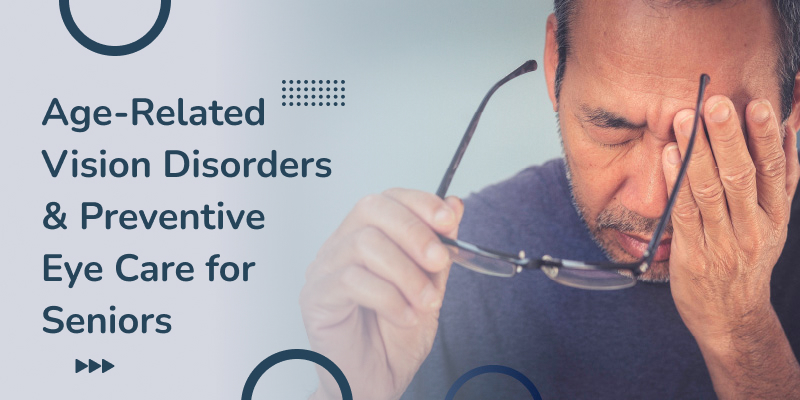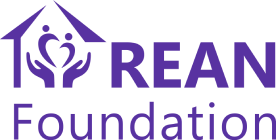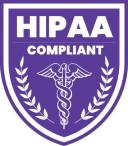
Age-Related Vision Disorders & Preventive Eye Care for Seniors
Aging is a gradual process that brings many physical changes, and vision impairment is one of them. According to the CDC, vision impairment is one of the biggest health concerns, affecting nearly 2.9 million senior citizens in the USA. It is estimated that the number of cases of early age-related macular degeneration will double by 2050, from 9.1 million to 17.8 million.
Any impairment with vision drastically compromises a person's quality of life because it hampers their ability to do even the simplest of activities like reading, walking, eating, and looking after their needs. The impact is double for older people.
You can't avoid aging, but you can avoid vision impairment. With vision so crucial to healthy aging, let's examine some common age-related vision disorders and what seniors can do to maintain healthy eyesight.
Eyesight Issues & Vision Changes Common Among Senior Citizens
Vision impairment is a common complaint after 40. Most people within this age group have difficulty focusing on objects up close. However, after 60, you are more likely to develop eye diseases that can permanently alter your vision.
Unlike other illnesses, eye disorders can sneak up on you without any warning or symptom. You may not even notice the changes until the condition is quite advanced. Let's look at some common eye disorders that particularly affect senior citizens.
1. Cataract
A cataract is the clouding of the lens inside your eye. In general, this lens is clear and enables unhindered vision. When a cataract develops, it clouds the lens, making it difficult to read, drive, or even notice the expression on a person's face. Most often, cataracts develop slowly in both eyes but may worsen in any one eye.
Cataracts cause:
- Clouded or blurred vision
- Decreased contrast sensitivity
- Increased glare sensitivity
- Dulling of colors
- Decreased ability to see in the dark
Fortunately, cataracts are easily treatable with surgery, which is commonly performed with a good success rate.
2. Retinal Detachment
Retinal detachment is a medical emergency where the retina (a tissue at the back of the eye) is pulled away from its normal position. Retina detachment happens almost instantaneously due to:
- Traumatic head or eye injuries
- Changes in the vitreous fluid in the back of the eye
- Inflammatory eye disorders
- Advanced diabetes
Retinal detachment requires immediate medical attention. If not, it could lead to permanent vision loss.
3. Diabetic Retinopathy
Diabetic Retinopathy is one of the most common vision-related complaints in people above 40 years of age. As the name indicates, this condition can occur in anyone with uncontrolled diabetes for a very long time. It occurs due to progressive damage to the blood vessels supplying blood to the retina. The damaged blood vessels bleed, causing the retina to swell and cloud your vision. Diabetic Retinopathy usually occurs in both eyes and at least one out of three diabetic patients above the age of 40. If not treated on time, it could lead to a permanent loss of vision.
4. Glaucoma
Glaucoma happens when fluid Aqueous Humor does not drain out and accumulates inside the eye, thereby increasing the pressure inside the eye. Glaucoma damages the optic nerve resulting in peripheral vision loss. This vision disorder affects both eyes, often starting in one and slowly affecting the other. It is also one of the leading causes of blindness in people above 60 years.
People with Glaucoma often do not notice any symptoms until they lose their side vision. Since untreated Glaucoma can result in blindness, getting your vision checked to detect the condition and commence the treatment without delay is imperative.
5. AMD or Age-Related Macular Degeneration
The Macula is the tiny center of the light-sensitive retina at the back of the eye, and its function is to enable you to see colors and fine details like designs, fine print, and facial features. AMD is a disease that affects the Macula. An aged person with AMD will have trouble reading, writing, watching TV, or recognizing faces.
6. Dry Eye
Dry eye is a condition where the eye becomes incapable of producing adequate tears. The lack of lubrication affects the health of the eye's front surface and impacts the quality of vision. Dry eye is a common problem among older people.
Also Read: "Discussing Gestational Nutrition Deficiencies and How to Combat Them"
Risks Associated With Vision Impairment
Aging brings with it a host of chronic diseases like diabetes, hypertension, arthritis, and cardiovascular diseases. Here again, we must remember that all senior citizens do not suffer from such ailments. Many of them are healthy and live to be a hundred years old. It is the senior population that suffers from such chronic illnesses and is more susceptible to vision impairments than those without them.
Adults with eyesight-related issues are also vulnerable to other physical and mental problems like:
- Social isolation
- Depression
- Mood swings
- Poor quality of life
- Increased dependency on others
- Fall-related injuries
- Inability to follow medication-related instructions
Age-related Vision Loss
Unfortunately, elderly people suffer more from vision loss than vision-related issues and changes. According to the World Health Organization, globally, the majority of people who have lost their eyesight are above the age of 50. However, this does not indicate that vision loss cannot affect people of other age groups.
Are all those who age and suffer vision impairments destined to suffer hardships and reduced quality of life? Not at all. Various solutions enable people with poor vision to live safely and efficiently.
Rehabilitation is perhaps the most promising solution to instill the elderly with the right resources to perform their daily activities with their remaining vision. Rehabilitative sciences teach them to use vision-enhancing devices such as:
- Spectacle-mounted magnifiers and telescopes.
- Hand-held and stand magnifiers.
- Video magnification devices.
- Talking wristwatches.
- Recorded books.
- Books & magazines with large print.
- Self-threading needles.
You may experience changes in your vision or eye health as you age. However, regular eye exams can help detect sight-robbing eye problems early when they are most treatable. Moreover, taking care of your eyes is similar to improving your overall health.
Given below are some effective tips to help you maintain good vision and eye health as you age.
The Best Lifestyle & Dietary Tips for Seniors to Improve Vision & Prevent Diseases
What you eat makes a world of a difference to your eye health. Here's a list of the foods and their nutritional contribution to your vision:
- Fish, eggs, and whole grain foods for essential fatty acids
- Broccoli, kale, tangerines, and oranges for Lutein and Zeaxanthin
- Almonds, pecans, sunflower seeds, and vegetable oil for Vitamin E
- Lean red meat, beans, and grains for Zinc
- Grapefruit, lemons, and papaya for Vitamin C
- Spinach, carrots, apricots, and sweet potatoes for Vitamin A
As you age, making some lifestyle changes will greatly enhance your chances of safeguarding your vision for the rest of your life. Make an effort to:
- Wear sunglasses while going out in the sun
- Punctuate your reading sessions with small breaks to avoid eye strain
- Get early treatment for genetically inherited eye diseases
- Exercise your eyes by rolling them from side to side
- Keep your blood pressure in check to prevent any damage to the blood vessels in your eye
- Get your eyes checked regularly to monitor any significant changes
Invest in REAN Foundation For Senior Vision Care
REAN Foundation's smart digital platforms are a great way to keep an eye on the vision health of seniors at home, no matter where you are. Using the REAN eyecare platform, seniors can efficiently manage daily eye care activities and prepare for vision-related problems. You can reach out to us for more information about our digital app.
Aging is a gradual process that brings many physical changes, and vision impairment is one of them. According to the CDC, vision impairment is one of the biggest health concerns, affecting nearly 2.9 million senior citizens in the USA. It is estimated that the number of cases of early age-related macular degeneration will double by 2050, from 9.1 million to 17.8 million.
Any impairment with vision drastically compromises a person's quality of life because it hampers their ability to do even the simplest of activities like reading, walking, eating, and looking after their needs. The impact is double for older people.
You can't avoid aging, but you can avoid vision impairment. With vision so crucial to healthy aging, let's examine some common age-related vision disorders and what seniors can do to maintain healthy eyesight.
Eyesight Issues & Vision Changes Common Among Senior Citizens
Vision impairment is a common complaint after 40. Most people within this age group have difficulty focusing on objects up close. However, after 60, you are more likely to develop eye diseases that can permanently alter your vision.
Unlike other illnesses, eye disorders can sneak up on you without any warning or symptom. You may not even notice the changes until the condition is quite advanced. Let's look at some common eye disorders that particularly affect senior citizens.
1. Cataract
A cataract is the clouding of the lens inside your eye. In general, this lens is clear and enables unhindered vision. When a cataract develops, it clouds the lens, making it difficult to read, drive, or even notice the expression on a person's face. Most often, cataracts develop slowly in both eyes but may worsen in any one eye.
Cataracts cause:
- Clouded or blurred vision
- Decreased contrast sensitivity
- Increased glare sensitivity
- Dulling of colors
- Decreased ability to see in the dark
Fortunately, cataracts are easily treatable with surgery, which is commonly performed with a good success rate.
2. Retinal Detachment
Retinal detachment is a medical emergency where the retina (a tissue at the back of the eye) is pulled away from its normal position. Retina detachment happens almost instantaneously due to:
- Traumatic head or eye injuries
- Changes in the vitreous fluid in the back of the eye
- Inflammatory eye disorders
- Advanced diabetes
Retinal detachment requires immediate medical attention. If not, it could lead to permanent vision loss.
3. Diabetic Retinopathy
Diabetic Retinopathy is one of the most common vision-related complaints in people above 40 years of age. As the name indicates, this condition can occur in anyone with uncontrolled diabetes for a very long time. It occurs due to progressive damage to the blood vessels supplying blood to the retina. The damaged blood vessels bleed, causing the retina to swell and cloud your vision. Diabetic Retinopathy usually occurs in both eyes and at least one out of three diabetic patients above the age of 40. If not treated on time, it could lead to a permanent loss of vision.
4. Glaucoma
Glaucoma happens when fluid Aqueous Humor does not drain out and accumulates inside the eye, thereby increasing the pressure inside the eye. Glaucoma damages the optic nerve resulting in peripheral vision loss. This vision disorder affects both eyes, often starting in one and slowly affecting the other. It is also one of the leading causes of blindness in people above 60 years.
People with Glaucoma often do not notice any symptoms until they lose their side vision. Since untreated Glaucoma can result in blindness, getting your vision checked to detect the condition and commence the treatment without delay is imperative.
5. AMD or Age-Related Macular Degeneration
The Macula is the tiny center of the light-sensitive retina at the back of the eye, and its function is to enable you to see colors and fine details like designs, fine print, and facial features. AMD is a disease that affects the Macula. An aged person with AMD will have trouble reading, writing, watching TV, or recognizing faces.
6. Dry Eye
Dry eye is a condition where the eye becomes incapable of producing adequate tears. The lack of lubrication affects the health of the eye's front surface and impacts the quality of vision. Dry eye is a common problem among older people.
Also Read: "Discussing Gestational Nutrition Deficiencies and How to Combat Them"
Risks Associated With Vision Impairment
Aging brings with it a host of chronic diseases like diabetes, hypertension, arthritis, and cardiovascular diseases. Here again, we must remember that all senior citizens do not suffer from such ailments. Many of them are healthy and live to be a hundred years old. It is the senior population that suffers from such chronic illnesses and is more susceptible to vision impairments than those without them.
Adults with eyesight-related issues are also vulnerable to other physical and mental problems like:
- Social isolation
- Depression
- Mood swings
- Poor quality of life
- Increased dependency on others
- Fall-related injuries
- Inability to follow medication-related instructions
Age-related Vision Loss
Unfortunately, elderly people suffer more from vision loss than vision-related issues and changes. According to the World Health Organization, globally, the majority of people who have lost their eyesight are above the age of 50. However, this does not indicate that vision loss cannot affect people of other age groups.
Are all those who age and suffer vision impairments destined to suffer hardships and reduced quality of life? Not at all. Various solutions enable people with poor vision to live safely and efficiently.
Rehabilitation is perhaps the most promising solution to instill the elderly with the right resources to perform their daily activities with their remaining vision. Rehabilitative sciences teach them to use vision-enhancing devices such as:
- Spectacle-mounted magnifiers and telescopes.
- Hand-held and stand magnifiers.
- Video magnification devices.
- Talking wristwatches.
- Recorded books.
- Books & magazines with large print.
- Self-threading needles.
You may experience changes in your vision or eye health as you age. However, regular eye exams can help detect sight-robbing eye problems early when they are most treatable. Moreover, taking care of your eyes is similar to improving your overall health.
Given below are some effective tips to help you maintain good vision and eye health as you age.
The Best Lifestyle & Dietary Tips for Seniors to Improve Vision & Prevent Diseases
What you eat makes a world of a difference to your eye health. Here's a list of the foods and their nutritional contribution to your vision:
- Fish, eggs, and whole grain foods for essential fatty acids
- Broccoli, kale, tangerines, and oranges for Lutein and Zeaxanthin
- Almonds, pecans, sunflower seeds, and vegetable oil for Vitamin E
- Lean red meat, beans, and grains for Zinc
- Grapefruit, lemons, and papaya for Vitamin C
- Spinach, carrots, apricots, and sweet potatoes for Vitamin A
As you age, making some lifestyle changes will greatly enhance your chances of safeguarding your vision for the rest of your life. Make an effort to:
- Wear sunglasses while going out in the sun
- Punctuate your reading sessions with small breaks to avoid eye strain
- Get early treatment for genetically inherited eye diseases
- Exercise your eyes by rolling them from side to side
- Keep your blood pressure in check to prevent any damage to the blood vessels in your eye
- Get your eyes checked regularly to monitor any significant changes
Invest in REAN Foundation For Senior Vision Care
REAN Foundation's smart digital platforms are a great way to keep an eye on the vision health of seniors at home, no matter where you are. Using the REAN eyecare platform, seniors can efficiently manage daily eye care activities and prepare for vision-related problems. You can reach out to us for more information about our digital app.



